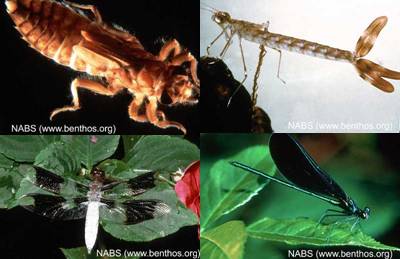Home → Water Quality → Monitoring & Reporting → Biomonitoring → Sampling & Analysis → Macroinvertebrate Types → Dragonflies & Damselflies
 Dragonfly & Damselfly Larvae (Odonata)
Dragonfly & Damselfly Larvae (Odonata)
Dragonflies and damselflies belong to an order of insects called Odonata that spends its juvenile life in the water and its adult life in the air and on land. Adult dragonflies and damselflies, collectively called Odonates, lay their eggs in the water. When odonate larvae hatch from these eggs they look essentially like adults with no wings. Each time they shed their skin they look a bit more like an adult dragonfly or damselfly. This type of life history is called incomplete metamorphosis.
Larval odonates, like all aquatic insect larvae with incomplete metamorphosis, have three body segments and six legs. They are usually 13-68mm in length, and can be distinguished from other insect larvae by their long, elbowed lower jaw, called a labium, which they use to catch prey. As larvae, dragonflies can be distinguished from damselflies by their stout body shape. The thorax and abdomen (body segments) of dragonflies are wider than their heads, while damselflies are long and slender, with a head wider than the rest of the body. Damselflies also have 3 long, flat gills on the rear of the abdomen that dragonflies lack. As adults, dragonflies are much more stout than damselflies. When at rest, adult dragonflies hold their wings away from their bodies, while adult damselflies hold their wings together above their bodies.
All dragonflies and damselflies are predators. They will eat anything they can subdue, so the size of their prey increases as they grow. While young larvae feed primarily on zooplankton, mature larvae feed on other macroinvertebrates and sometimes even small fish. They catch their prey either by stalking it or waiting in the sediment and ambushing whatever comes along. As adults odonates continue to prey on other insects, such as mosquitoes.
Odonate larvae can be most commonly found in shallow areas of ponds, lakes, bogs, and wetlands as well as in still portions of streams and rivers. Some types of odonates are also found in faster currents. Dragonflies are often found burrowed into soft substrate or climbing and crawling amongst vegetation and debris. Damselflies are mostly found climbing on vegetation or plant debris. Though most damselflies live in still water, some are well adapted to live amongst the cobbles in fast running riffle areas of streams.
Both damselflies and dragonflies breathe dissolved oxygen through gills on the abdomen. Dragonfly gills are located inside the abdomen, while damselfly gills are external. Both can absorb some oxygen through their skin, so long as it stays moist. Some damselflies and dragonflies cope with low dissolved oxygen by climbing to the surface and absorbing oxygen from the air through their skin. Some dragonflies leave just the tip of their abdomen exposed above the water surface and pump air into the internal gills. Dragonflies range from very sensitive to very tolerant of stresses such as low dissolved oxygen that are caused by pollution. Dragonflies that are sensitive to pollution are those that wait burrowed in the sediment to ambush their prey, where oxygen is first depleted when nutrient pollution occurs. Damselflies are moderately tolerant of pollution.
Picture key
Top Left: Dragonfly larva (Progomphus obscurus)
Bottom Left: Adult dragonfly (Plathemis lydia)
Top Right: Damselfly larva (Family: Lestidae)
Bottom Right: Adult damselfly (Calopteryx maculata)
Source: All pictures taken from The North American Benthological Society
Bibliography
Voshell, Jr., J. Reese; illustrated by Amy Bartlett Wright. 2002. A Guide to Common Freshwater Invertebrates of North America. Blacksburg (VA): The McDonald & Woodward Publishing Company. 442 p